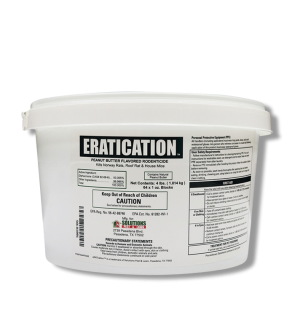Anticoagulant
Most Effective Products
Anticoagulant

A chemical that is used to treat illnesses and diseases in humans is at the same time a toxic chemical to rodents like rats and mice--anticoagulants. Anticoagulants have been used medically to prevent stroke, heart attacks and other issues but in the world of pest control, it is one of the top chemical types used in rodenticide baits.
On this page, you will learn about anticoagulants, how they work, their benefits and how to use it safely to bait for rodents. Here you can also shop anticoagulant products we available that our experts highly recommend.
What are Anticoagulants?
Anticoagulants, also commonly known as blood thinners, are a chemical substance that helps to prevent blood from coagulating or clotting. In human medicine, it is a popular drug that has saved countless lives. In the world of pest control, anticoagulants are an effective method of rodent control.
Some of the popular anticoagulant active ingredients include warfarin, the first-ever developed anticoagulant. Warfarin made way for the development of other anticoagulant variants such as bromadiolone, chlorophacinone, diphacinone, and brodifacoum.
How Do Anticoagulants Work?
Anticoagulants are often mixed with a food a grade attractant that is palatable to rodents. Anticoagulants work by affecting a special enzyme in the body called Vitamin K, which help the blood to clot. When a rodent consumes the anticoagulant bait, the anticoagulant formula disrupts their normal blood-clotting functions so the rodent dies by bleeding internally. Anticoagulants are either classified as 1st generation or 2nd generation anticoagulants which means that a lethal dose can occur either via multiple feedings or a single feeding.
Benefits of Anticoagulants
Anticoagulants are effective means of rodent control and does not involve you having to directly encounter a rodent. Simply place the bait strategically and let the rodent come to it on their own and consume it. Anticoagulant is also a pain-free means of control. Rodents will not be able to detect that anything is wrong with them or attribute their condition with the bait so they will carry on as normal until they suddenly die from the bait.
Anticoagulants are also a low hazard to people and non-target animals. You would have to consume a lot of anticoagulant to be harmed by it so the chances of accidental consumption doing serious damage are slim. Even then, anticoagulant has an antidote to prevent accidental poisonings in the form of Vitamin K1.
It is important to note that even though second generation rodent baits are commonly referred to as "single-dose" anticoagulants, this doesn not necessarily mean that a rodent will die instantly. The rodent will receive a lethal dose on the first feeding, but they may continue to feed for several days. Because of this, second generation rodent baits are especially useful in areas where there is a lot of competing food sources. Because it will only require a one-time feeding, the success rate will generally be higher.
Drawbacks of Anticoagulants
While anticoagulants are effective in killing rodents, it is not an instant kill. Rodents will often have to consume anticoagulant bait multiple times over a number of days to get a lethal dosage. Some rodents can develop resistance to anticoagulants, rendering the method of control ineffective.
We advise against using anticoagulant bait as a way to control rodents and instead opting for rodent traps if you want a very quick kill.
Are Anticoagulants Safe?
Anticoagulants are safe to use when applied carefully according to the product label. It is important to wear the proper PPE in the form of gloves when applying bait and also utilizing a bait station to keep non-intended targets from getting to the product and consuming it (pets and small children).
What To Expect

Depending on whether you are using a 1st generation (multi-feed) or 2nd generation (single-feed) anticoagulant, you will need to continuously monitor your bait placement to check if rodents have been consuming the bait. If they have been eating bait, quickly replenish with new bait until there is no further activity or until you find a dead rodent on the premises.
There is a possibility that poisoned rodents will die in a hard to reach area where you won't be able to dispose of them (if they are in a wall void, crawl space, air vent etc.). In such a case you may have to deal with the inconvenience of the dead rodent decomposing, which will have a strong off-putting smell for a number of weeks.
Featured Products
Eratication Rodent Bait - Eratication Rodent Bait is a synthetic rodenticide made with the chemical diphacinone. It is used to eradicate rats and mice. Eratication is easy to apply and kills target pests within 2 to 4 days.











































































































































































































































































































































































































































































































































